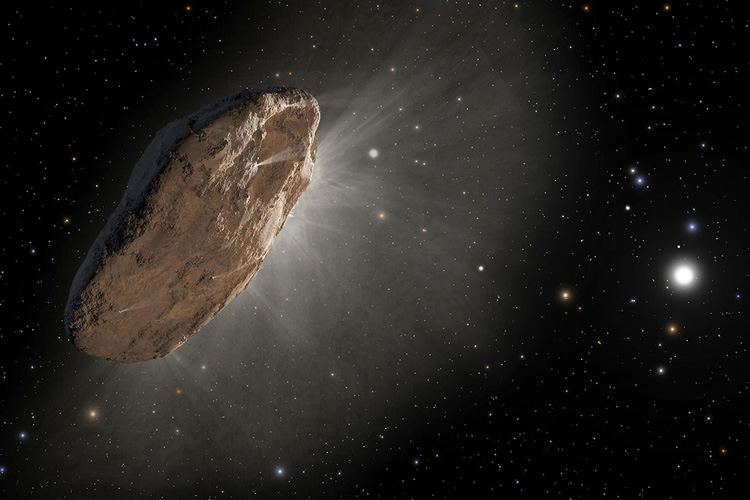Nothing excites space enthusiasts like a good alien mystery. The interstellar visitor 'Oumuamua presented one as it moved through the inner solar system in 2017. At least one scientist has insisted that this pancake-shaped object is an alien spacecraft. That's because of the way it accelerated away from the Sun as it passed through. However, a number of planetary scientists say its activity might be more comet-like—something fairly common in the solar system.
Certainly, a lot of theories floated around about which natural events could cause 'Oumuamua to accelerate away. At least one of them invokes nitrogen outgassing, although that theory has some problems. It could be more like icy Pluto. Or, maybe it's some kind of interstellar "dust bunny" made of materials stuck together in a weird shape.
A new study by a pair of astronomers solves at least part of the mystery by using chemistry. They suggest that hydrogen gas (H2) got formed and trapped in 'Oumuamua thanks to millions of years of cosmic radiation. Once it experienced even a little heat from the Sun, the hydrogen gas was released. That provided a sort of "jet engine effect", giving the object a surprising amount of acceleration as it left.
Explaining Oumuamua's Outgassing and Acceleration
University of California Berkeley astrochemist Jennifer Bergner came up with the outgassing explanation and brought it to the attention of colleague Darryl Seligman, who is a postdoctoral fellow at Cornell University. Bergner studies chemical reactions that happen on icy rocks in the vacuum of space. "A comet traveling through the interstellar medium basically is getting cooked by cosmic radiation, forming hydrogen as a result," Bergner said. "Our thought was: if this was happening, could you actually trap it in the body so that when it entered the solar system and it was warmed up, it would outgas that hydrogen? Could that quantitatively produce the force that you need to explain the non-gravitational acceleration?"
Bergner and Seligman studied the idea further and found a clue in decades-old research about ice behavior in space. When high-energy particles (like cosmic rays) hit an icy body, the process produces and traps molecular hydrogen (H2) inside. Cosmic rays (which travel at nearly the speed of light) can penetrate quite deeply into ice. That could convert a quarter (or more) of an icy body's water to hydrogen gas.
Traveling through space, a comet with a lot of H2hidden away would remain that way indefinitely. But, as we know from studying comets, solar radiation affects icy objects. Once a comet nucleus approaches the inner solar system, that radiation causes volatiles to vaporize. Thar creates a stream of gas and dust that creates the coma, dust, and plasma tails.
Did This Happen to 'Oumuamua?
Bergner explained how subsequent outgassing of H2could have happened to this little body. Astronomers estimate it's about 115 by 111 by 19 meters in size. "For a comet several kilometers across, the outgassing would be from a really thin shell relative to the bulk of the object, so both compositionally and in terms of any acceleration, you wouldn't necessarily expect that to be a detectable effect," she said. "But because 'Oumuamua was so small, we think that it actually produced sufficient force to power this acceleration."
If it's a comet from another star system, that gives scientists new insights into conditions elsewhere in our galaxy. We know comets are the icy leftovers of star and planet formation. This makes them a great way to probe the conditions in the solar nebula 4.5 billion years ago. If the same formation activities happened elsewhere and created 'Oumuamua. then it's a treasury of information about its home system.
"What's beautiful about Jenny's idea is that it's exactly what should happen to interstellar comets. We had all these stupid ideas, like hydrogen icebergs and other crazy things, and it's just the most generic explanation," Seligman said. "The comets and asteroids in the solar system have arguably taught us more about planet formation than what we've learned from the actual planets in the solar system," Seligman said. "I think that the interstellar comets could arguably tell us more about extrasolar planets than the extrasolar planets we are trying to get measurements of today."
If this holds true for 'Oumuamua, then it solves the essential mystery of this alien object. And, it's actually more exciting than aliens. It gives an interesting look at star and planet formation in other places in the Galaxy.
For More Information
Surprisingly simple explanation for alien comet ‘Oumuamua’s weird orbit
Acceleration of 1I/‘Oumuamua from radiolytically produced H2 in H2O ice
 Universe Today
Universe Today

